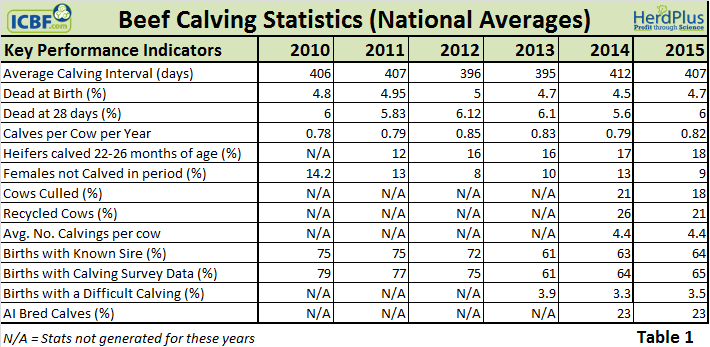The 2015 HerdPlus Beef Calving reports were released this week. This report is designed to give farmers an in depth insight into the reproductive performance of their herds. The calving reports run from mid-year, therefore the 2015 data covers the period from 1st July 2014 to 30th June 2015.
The most visible change that can be seen following the publishing of these reports is that there has been short-term improvement to the fertility within the national suckler herd. The average calving interval improved by 5 days from 412 days in 2014, to 407 days in 2015. However, there hasn’t been a major change over the past five years with the figure for calving interval in fact the same today as it was a half-decade ago. (See graph above).
Similar trends are apparent one year on for other important fertility parameters such as calves per cow per year, percentage of heifers calved 22-26 months of age and percentage of females not calved in period (See Table 1 below). The National Statistics are based on cows with 5 calvings or more with data coming from 46,590 herds.
 The percentage of heifers calved 22-26 months of age is showing slow but steady improvement as can be seen in “Table 1” above. An important aspect of calving beef heifers at 24 months is making sure that they meet target weights. Weighing all cattle is good practice and this is particularly true for replacement heifers. Farmers can do this by using their own scales and subsequently recording weights on the ICBF website, or they can avail of the ICBF technician service. Once heifers are weighed farmers can assess performance levels accurately and see where their heifers stand in relation to targets. The table below gives a simple outline of target weights at different ages, for calving beef heifers at 24 months.
The percentage of heifers calved 22-26 months of age is showing slow but steady improvement as can be seen in “Table 1” above. An important aspect of calving beef heifers at 24 months is making sure that they meet target weights. Weighing all cattle is good practice and this is particularly true for replacement heifers. Farmers can do this by using their own scales and subsequently recording weights on the ICBF website, or they can avail of the ICBF technician service. Once heifers are weighed farmers can assess performance levels accurately and see where their heifers stand in relation to targets. The table below gives a simple outline of target weights at different ages, for calving beef heifers at 24 months.

Although calving interval etc. has seen some improvement from the 2014 figure, not all parameters show the same positive results a year on. The percentage of calves dead at birth is up from 4.5% in 2014 to 4.7% in 2015. Similarly the percentage of calves dead at 28 days is up from 5.6% in 2104 to 6% in 2015.
The top 15% of herds had a calving interval of 363 days which equates to a calving interval that is all of 6.3 weeks greater than the figure for the national herd average of 407 days. This figure is some way behind that of the top 15% and with the calving interval figure for the national herd showing no change over the past half-decade, it has never been so important that we focus our breeding on bulls with a high Eurostar Replacement index with a high fertility sub-index.
Year on year figures indicate that we are moving in the right direction, however with no change to the calving interval figure over the past 5 years, it is important to focus on improving the fertility of the national herd. With the introduction of the Beef Data and Genomics Programme and more focus on 4 and 5 star replacement breeding stock as a result, the national herd will see improvement to this figure in the future and the trend for future years will show a more positive outcome as a result of this.
A full listing of all the beef statistics can be found on the ICBF Statistics page. If you have any questions on the calving report, the above statistics, or the Euro-Star ratings of animals, please do not hesitate to call ICBF HerdPlus® on LoCall 1850 600 900 or 023 88 20452.
